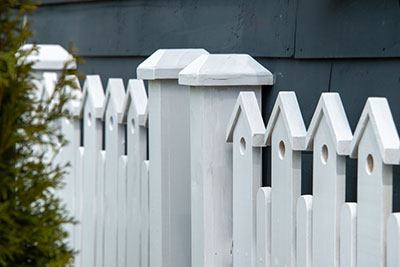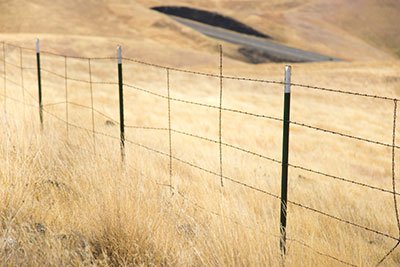Are you considering constructing a new farm fence? You’re probably wondering what type of post spacing will best fit your needs.
Figuring out the ideal fence post spacing for your property isn’t always easy. This guide is here to provide the necessary information and make it simple for you.
We’ll explain all the factors that go into determining proper farm fencing post spacing, including cost-effectiveness, longevity, size variations, and more.
Take away key points:
- There are various pace measures for different fence posts
- You need to know the fence types in advance to ensure the suitable posts and their space to make sure the fencing will be secure and stable
- Refer to our guide below for more fence post space information
Table of Contents
- What is post spacing?
- Before you start…
- Once you start the project…
- How far apart should post spacing be?
- What’s the average distance of the fence posts?
- Proper fence post spacing examples
- What factors impact the fence post spacing?
- Factors affecting strainer post space
- Will ground conditions affect the space between the fence posts?
- Installing fence posts correctly
- FAQs
- Final thoughts
You need to know the right fence post distance for your optimal field fence styles. But this is easier said than done.
We will help you determine the proper spacing for your fence line posts. You’ll ensure straight fences and appropriate spacing for different fence types.
What is post spacing?

Post spacing is the distance between fence posts and can be influenced by a variety of factors. However, there are some general guidelines to follow. It is crucial that fence post spacing is done correctly to ensure effective and durable fencing.
If the post spacing is inadequate, even a minor force on the fence may cause significant damage or collapse. Typically, the standard fence post spacing is around 6 to 8 feet or 1.83 meters.
Before you start…
Before you begin building a fence, make sure to check the property lines and confirm their accuracy. Doing so will save you time and potential issues down the road.
Additionally, it’s always crucial to call before digging to make sure there are no hidden dangers like electrical cables, water, or gas pipes buried underground. Depending on your region, different numbers and offices should be contacted for this purpose.
Once you start the project…
Before installing fence posts or the fence itself, it’s recommended to create a map that includes all aspects of your property, including property lines, natural barriers, and underground utilities.
Once you’ve finished the sketch, it’s essential to mark down the fence support elements, such as:
– Brace posts to secure the fence and provide support for its weight
– Line posts to offer support throughout the fence length
– T-posts to keep the fence vertical
– Boss posts that ensure stability in areas of severe dips, hips, and ledges.
How far apart should post spacing be?
To determine the ideal post spacing for your fencing, many factors come into play: the fence’s design, the type of wood being used, and the terrain where the fence will be erected.
Proper post spacing is crucial to achieving a functional and cost-effective fence.
1. Fence T post spacing standards
T post fence spacing refers to the distance between T posts, which is typically 3 feet or 4 feet for most fencing projects. However, it is not restricted to these measurements and can be adjusted based on the fencing requirements.
The wider the gap between T posts, the greater the likelihood of them collapsing during a storm or high winds. For cattle ranching, one strand of barbed wire combined with a single 8-foot T post can suffice.
As for the distance between T posts for this type of fence, it varies as the first T post is set 8 feet back from the fence’s end. The second T post’s starting point is also 8 feet from the fence end, while the third is placed 12 feet back and the fourth 16 feet back. This setup is used for 24-foot fences with 8-foot T posts.
2. What’s the distance between posts for wire fence systems?
Determine the distance between posts for your wire fence system, it depends on the type of fence you are installing.
For example, standard barbed wire fences typically have posts spaced 10 to 12 feet apart, while woven wire fences have posts spaced every 12 feet.
High tensile barbed wire also needs spacing between 12-15 feet apart, while Smooth Wire can have post spacing of up to 30 feet.
If you’re looking to install an electric fence, it’s important to determine how many wires and what spacing to use.
For a two-wire fence, the first wire should be 22 inches from the ground and the top wire 40 inches. A timeless fence system is also a great option if you’re looking for consistent wire spacing using droppers between posts.
Whether you’re looking for a chain link fence or a high tensile fence system, there are certain guidelines to follow. Terminal posts for chain link fences are typically 36″ longer than the height of the fence being installed. High tensile fences require electrical jumper connections between all electrified fence wires, using a length of 12 1/2 gauge wire as a jumper.
High-tensile fence post spacing, such as high-tensile wire fences, is preferable to traditional wooden fences due to their cost-effectiveness, longevity, and aesthetic appeal.
However, it is essential to consider the spacing between wire fences (line posts) and the materials used when deciding where to place the high-tensile steel line posts for a new field fence on your property.
Different types of high tensile field fences have varying fence post spacing requirements.
For instance, field fences (high tensile) may have a maximum distance of up to 16.5 feet between posts for fence construction, while field fences (low carbon) typically have a spacing of 8 feet apart for different property lines.
3. Wooden fence spacing
Wooden fences are widely used and popular in the present day. The wooden post spacing for a basic board or picket fence is typically around 4 to 5 feet.
For individual wooden posts and fence boards, a distance ranging between 5 and 8 feet is usually chosen for such property lines. Ensure you use the T posts on one wooden post for a successful structure of fence wire stretched around your wooden posts.
What’s the average distance of the fence posts?

Determining an average post fence spacing is difficult due to the lack of standardization practices. Nonetheless, there are a few published estimates that generally range from 3 to 7 feet for fence posts.
In the United Kingdom, an average of 6 feet is commonly used, while in the US, posts are typically spaced 10 feet apart along a property line and 6.5 feet apart within a property for a specific type of fence.
It is important to note that these standards can vary based on the type of fence and materials used.
Proper fence post spacing examples
Here are some models of spacing posts for your future robust fence. Find your perfect solution for the specific type of fence for your needs:
1. Crop fence posts
Crop fencing, which is intended to restrict pests such as kangaroos and pigs, rather than retaining livestock, is usually implemented over flat terrain. Typically, fence posts are 5 meters far apart. This fence post model is adequate for most situations.
However, if there is a significant issue with large pigs or kangaroos, then reducing the spacing to 4 meters may be necessary.
2. Sheep fence posts on flat ground
When it comes to sheep fencing on flat terrain, the wires of the electric fence must be highly tensioned to prevent young lambs from escaping.
Compared to larger livestock, sheep tend to apply less pressure against electric fences. As a result, a fence post spacing of 4 meters should be sufficient to contain your sheep inside the fence wire.
3. Sheep fence posts on hilly ground
Regarding sheep fencing on hilly terrain, the space in fence posts of 4 meters should suffice to retain your sheep inside the line posts. As with fencing on flat ground, sheep typically exert lower pressure against a fence than larger animals.
Any changes in topography can be addressed by including a strainer fence post in your fencing setup.
4. Cattle fence posts on flat terrain
Concerning cattle fence posts, the strength of your fence wire mainly depends on the strainer posts. A post space of 4 meters is usually enough to retain your cattle.
However, rowdy cows that regularly push fences may require a more rigorous approach. Including additional inline strainer posts after every 3 or 4 fence posts instead of after every 5th post can reinforce the fence’s integrity against large animals and larger spacing.
5. Cattle fence posts on hilly terrains
When installing cattle fence posts on hilly terrain, the strength of the fence heavily relies on the strainer posts. A 3 meter spaced T post spacing for electric fence is usually sufficient to retain your cattle, taking into account any changes in topography by including a strainer post.
For rowdy cows that tend to push fences, adding extra inline strainer posts after every 3 or 4 pickets, instead of after every 5th picket, can reinforce the fence’s structure against large animals.
So, more pickets will result in better future maintenance and usage of the fences, as they provide extra support for the fencing systems.
What factors impact the fence post spacing?
Here are some of the factors that might impact your overall fence performance:
1. Wire number on your fences
When dealing with a significant number of wires, say between 9 to 12, additional support is required. To hold the extra weight, you have to space your pickets closer together.
2. Size & pressure of your livestock
A larger cattle example, such as cows, requires a stronger fence due to the extra tension exerted by the animals against the fencing. That’s why you need to space your pickets closer together at the same distance for additional reinforcement.
High tensile barbed wire can help act as a deterrent but won’t be enough support on its own. For smaller stock such as sheep and goats, you can space your pickets far apart.
3. Type of terrain
The landscape you’re fencing in will determine how much space you need between the fence posts. If it’s a flat surface, you can have more distance between each one. But, if there are hills and valleys, you’ll probably need to keep the fence posts closer together to fit the contours of the land.
Factors affecting strainer post space
Here are some of the factors affecting the strainer fence posts:
1. Type of livestock
The spacing between fence posts may differ based on the type of livestock, but it doesn’t have a significant impact on the strainer posts. A sturdy steel strainer post with a diameter of 80NB (89mm O.D) will earn more points in supporting the fence, regardless of whether you’re raising cows or chickens.
Also, if you’re using temporary fencing for your livestock, increased spacing is the best solution for your fencing standards. You don’t need to use an electrified wire and you can provide more space between the end posts and regular fence posts. You will easily move the fencing to other places.
2. Topography
When dealing with significant changes in terrain, using a strainer post is essential. If your fence runs along a gully, an inline strainer post at the bottom will prevent the fence wire from pulling out the star picket due to strain. A strainer post can remain firmly secured amidst such constant fence tension.
At the top of a hill, using an inline strainer post instead of a star picket will keep your fence posts from being pushed into the ground under the strain of the fence wire.
As another example, in a flat plain with a straight fence line and no dips or hills, you can safely space strainer posts hundreds of meters apart.
3. Changing directions
A strainer post is usually needed when there is a change of direction, particularly for heavy-duty fences. The fence tension in the wire will cause a picket to bend or be pushed out of alignment.
A strainer fence post can withstand the pressure and stay upright, especially with the use of a stay for highly strained fences.
4. Fence wire numbers
For light-duty fences with 3 or 4 wires, or an electric fence, star pickets can be used for minor changes in terrain.
In most cases, however, a strainer post should be used to ensure that the fence is secure and well-positioned, especially for heavier-duty applications.
5. Gateways
To ensure the strength and durability of a gateway, it is recommended to have a strainer end post assembly on both sides.
6. Strainer thickness
Thicker walls in a fence offer greater strength and resilience, so steel strainer posts of 80NB or above (89mm O.D or 114mm O.D) can be spaced further apart for a stronger and more secure fence.
Anything less than 80NB will compromise the integrity of the fence and require more components and cost more to implement.
Will ground conditions affect the space between the fence posts?
The condition of the ground plays a crucial role when setting up a fence. While you may assume that adding more posts is the optimal solution, the depth of each post is more critical.
If you’re operating in an area with black soil or clay, using longer posts that can penetrate deeper into the ground will offer better fence stability. Alternatively, you may consider DriveTight end assemblies for increased ground anchorage.
In sandy soil, you must set the fence posts deeper for greater fence stability, as opposed to including additional strainers. However, if you’re working with rocky soil, driving posts and pickets into the ground may be difficult. Still, the rocks themselves provide greater support, ultimately strengthening the fence, and increasing their life expectancy.
Installing fence posts correctly

Here are the steps to follow to correctly install fence posts for your needs:
– Start by digging the post holes using a manual posthole digger or an auger, making sure to bury at least a third of the length of the fence post. Most picket or lattice fences require posts to be placed 6 to 8 feet apart on center, with each hole dug 24 inches deep into the ground.
– Choose the right type of fence post for your needs. Not all fence posts are ideal for installation without concrete, so select the appropriate posts based on the type of fence you want to install.
– Set the posts securely in place by adding concrete mix around the perimeter of the post in the hole, carefully following the manufacturer’s instructions for the mix.
– Allow the concrete to set for at least 24 hours before attaching the fence panels to the posts.
FAQs
How far apart should fence posts be for the field fence?
Most fence posts can be between 8 and 12 feet apart, but some posts might be:
– 12-20 feet apart for field fences,
– 20 to 30 feet apart for fence posts for barbed wire or smooth wire.
Depending on the type and purpose of the fences, you can find how much space you need for the longevity fence systems.
How deep should farm fence posts be buried?
The fence posts should be at least 1/3 or 1/2 of the above-ground of height of the fence post. The same goes for the end post models, gate posts, and brace posts.
What is the post spacing for the hog wire fence?
The best spacing is between 12 and 20 feet apart, depending on the fence wire choice.
How far apart should the fence post be for woven wire?
Post spacing for woven wire fence should be 16 feet (standard version).
How far apart do you put T posts?
The optimal space between the two posts should be between 8 and 25 feet far apart. You must consider the soil, terrain, animals, pressure, and turns in the fencing lines.
Final thoughts
Taking the time to properly consider how best to space your posts is an important task that shouldn’t be taken lightly. The decision has wide-ranging implications and you will want to strongly consider each variance before making a final determination.
Remember, you can always rely on property marking professionals to achieve the right spacing for your farm fence. Finding the right post spacing for your farm fences isn’t easy, but it’s certainly worth it in terms of aesthetics and performance.
Ultimately, following a few simple steps instead of guessing at fence post spacing will ensure a strong and sturdy fence that stands the test of time.
